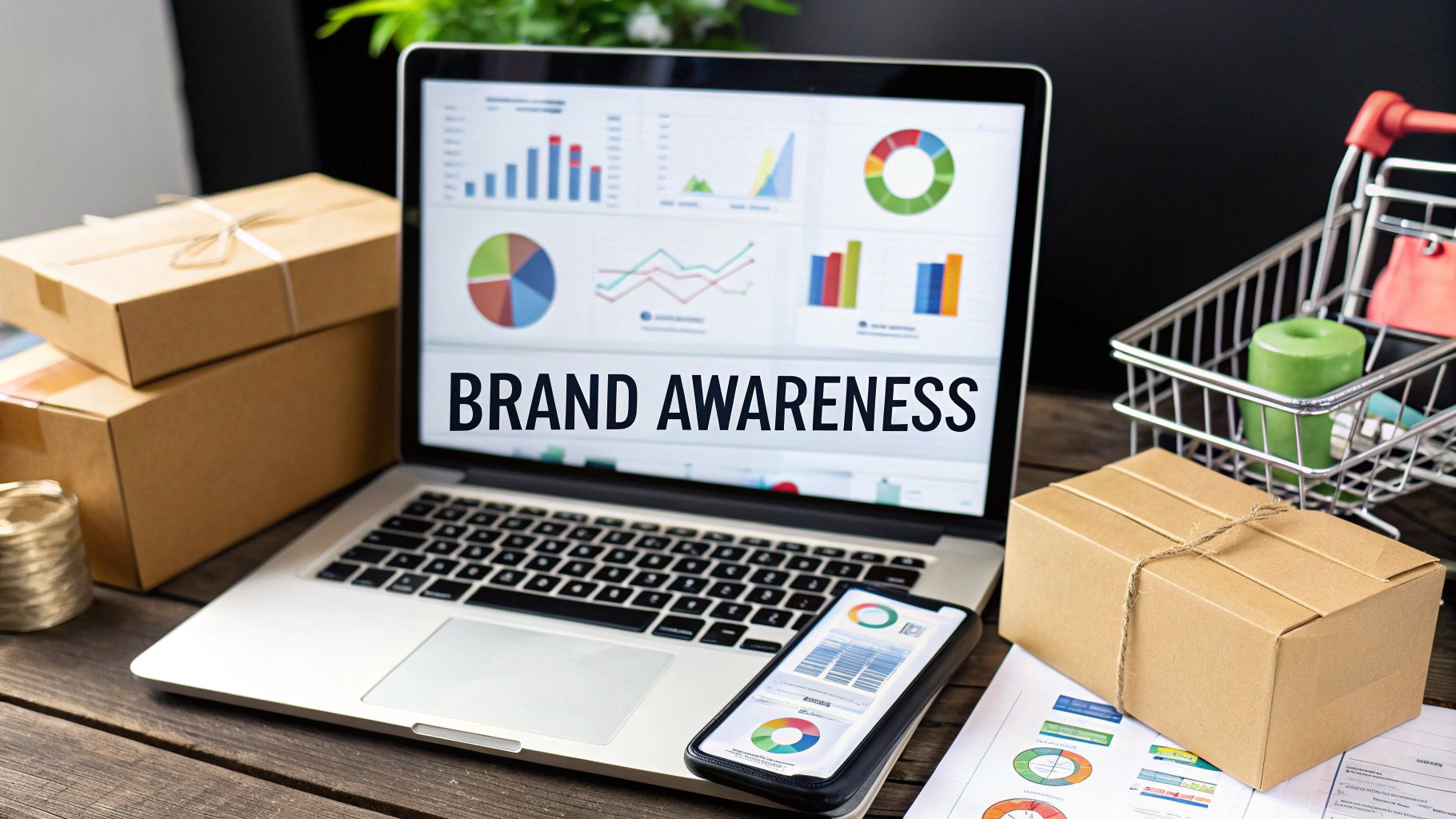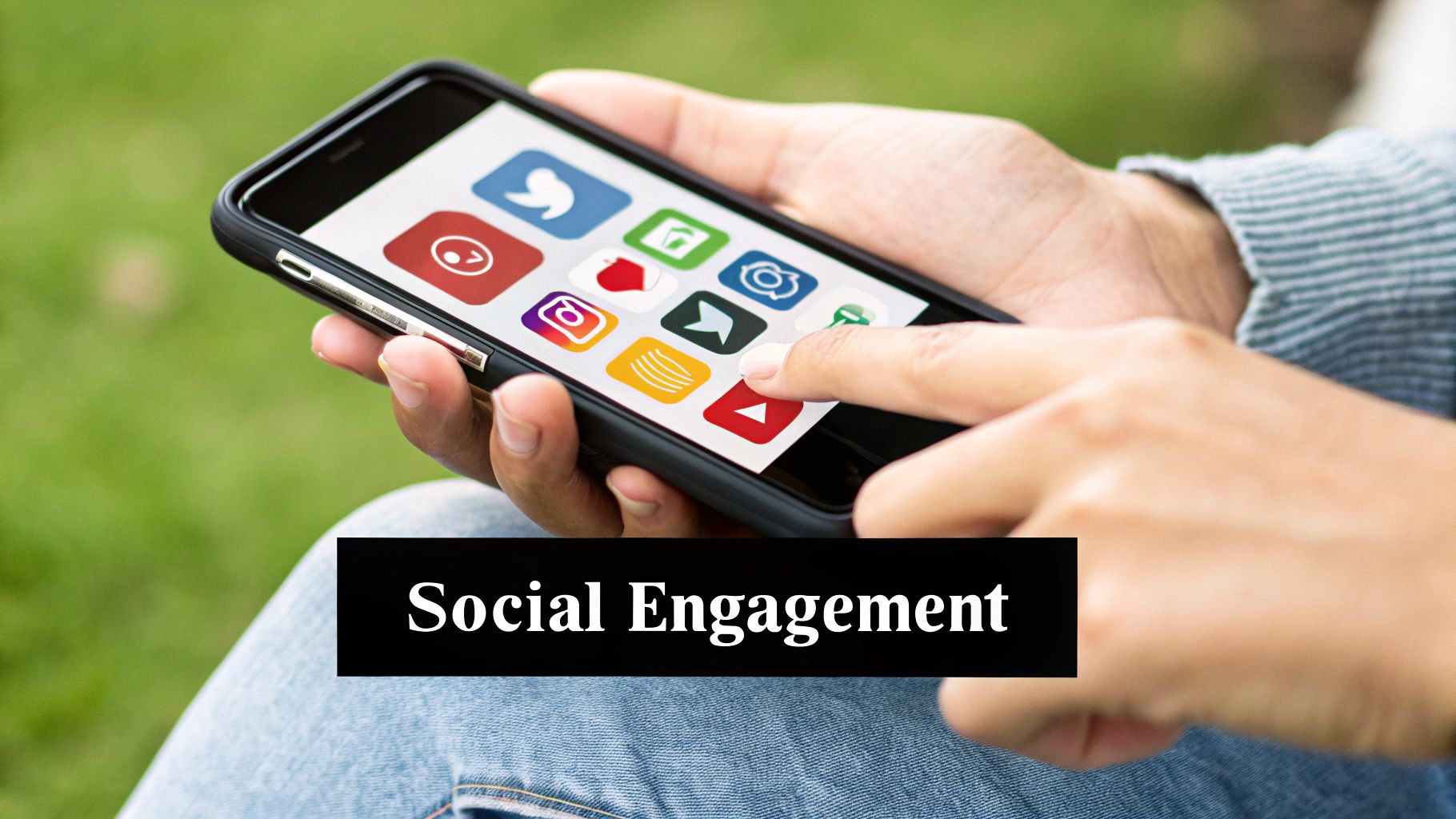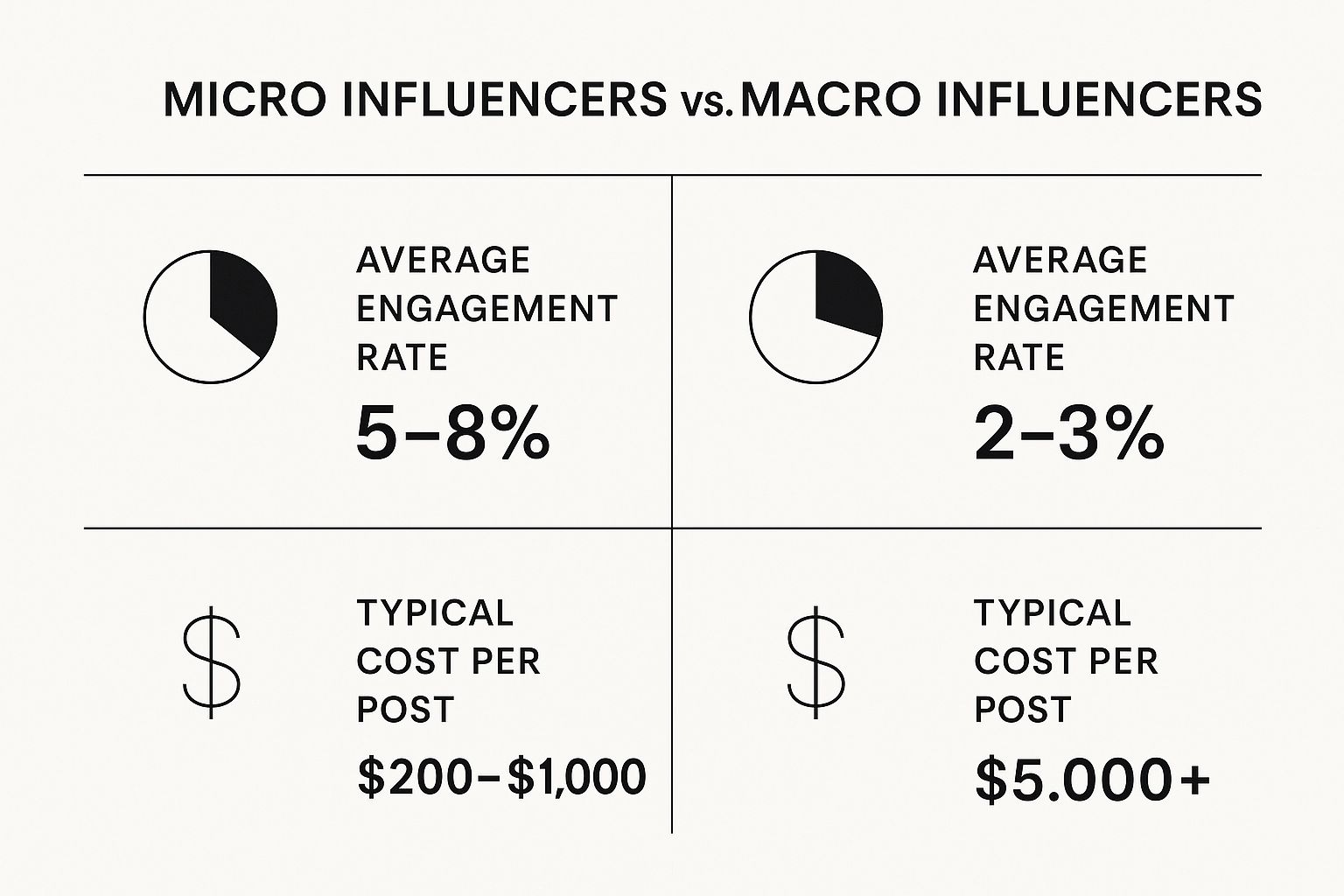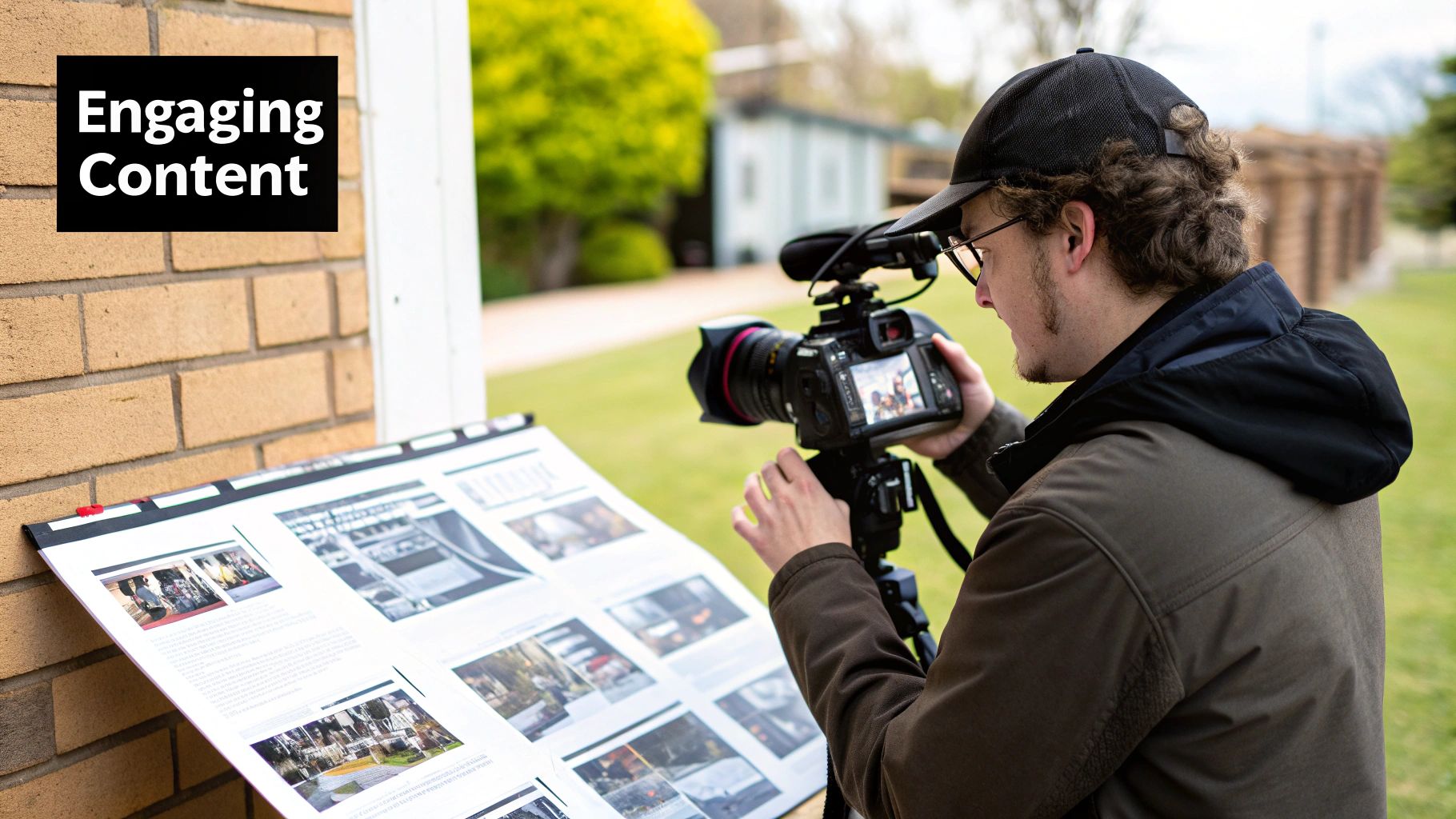Stay Updated with Everything about MDS
Thank you! Your submission has been received!
Oops! Something went wrong while submitting the form.

Chilat Doina
July 25, 2025
Brand awareness is so much more than just getting your logo out there. It’s the art and science of making your brand instantly recognizable and—more importantly—memorable to the people you want to reach. The process involves crafting a consistent brand identity, creating genuinely valuable content, and showing up where your customers are.

So many entrepreneurs I talk to think brand awareness is just about plastering their logo everywhere. While recognition is a piece of the puzzle, true awareness digs much, much deeper. It’s the difference between someone spotting your name in a sea of competitors and them actively choosing you because they know who you are and trust what you're about.
Your brand isn't just your product. It’s the entire experience someone has with your company. It’s the feeling they get from your packaging, the voice they hear in your social media captions, and the reliability of your customer support. It's everything.
At its core, building brand awareness is about building relationships at scale. You’re not just trying to push a product; you’re carving out a space for your brand in your customers' lives. And you can only do that by earning their trust.
In fact, trust is the single most critical factor here. It’s what turns a casual browser into a loyal customer. According to a 2025 survey from Edelman, a staggering 81% of consumers said they need to trust a brand before they'll buy from it. That stat says it all—trust is non-negotiable. If you want more proof, you can dig into these brand awareness statistics to see the bigger picture.
True brand awareness isn't about being the loudest voice in the room. It’s about becoming the most trusted and familiar one—the go-to solution when a need arises.
So, how do you actually build brand awareness that translates into real business growth? It's not about a one-off viral video or a slick tagline. It’s a sustained effort built on three core pillars that work in harmony to create a brand people remember and rely on.
Identity: This is your bedrock. It’s about getting crystal clear on who you are, what you stand for, and who you’re talking to. Without a solid identity, all your marketing will feel disjointed and confusing.
Content: This is your voice. It’s how you share your value, flex your expertise, and connect with your audience on a human level. Good content doesn't just sell; it informs, entertains, and positions you as the authority.
Engagement: This is your relationship. It’s how you interact with your audience, build a thriving community, and turn passive followers into your biggest cheerleaders.
Getting these pillars right is the first step. To make this framework crystal clear, I’ve put together a table that breaks down how each piece contributes to your overall strategy.
This table breaks down the three essential pillars of a rock-solid brand awareness campaign. Think of it as your quick-reference guide to the key strategic areas we'll be diving into.
With this structure in mind, you're not just throwing things at the wall and hoping something sticks. You're building a deliberate, cohesive brand presence that will pay dividends for years to come.

Before you can expect anyone else to get what your brand is about, you need to know it inside and out. It all starts with building a rock-solid brand identity. This isn't just about a slick logo or a catchy tagline; it's the very soul of your business.
Think of your brand identity as your North Star. It’s the constant that guides every tweet, every product description, and every customer service email. This ensures that no matter where or how a customer interacts with you, the experience feels consistent, authentic, and genuinely you.
Let's get real for a second. Beyond making a profit, why does your brand exist? That's your mission. Maybe it’s to make sustainable living accessible, to spread joy with handcrafted goods, or to make complex software dead simple for small businesses.
Your values are the non-negotiables that guide how you bring that mission to life. They dictate how you treat customers, where you source materials, and the kind of team you build.
Take a brand like Patagonia. Their mission is crystal clear: protect the planet. This core mission dictates their values, like using sustainable materials and famously donating a chunk of their sales to environmental causes. That clarity is magnetic, attracting a loyal tribe who shares those same beliefs.
How does your brand sound? Is it witty and informal like Wendy's on X (formerly Twitter)? Or is it more authoritative and reassuring, like a financial advisor? Your brand voice is the personality that shines through in all your communication.
Think about it like this:
A consistent voice makes your brand feel less like a faceless company and more like a real person, which is how you build a real connection. To get that voice just right and stand out, you'll want to explore different ecommerce branding strategies that help you find your unique sound.
A brand without a defined identity is like a ship without a rudder. It might be moving, but it has no control over its direction, leaving its success up to chance and the whims of the market.
Our brains process images at lightning speed, which makes your visuals an incredibly powerful tool for brand recall. A cohesive visual identity makes sure your brand is instantly recognizable, whether it's on an Instagram feed, a product package, or your website.
In fact, visual consistency pays off big time. 60% of companies reported that keeping their branding consistent led to a 20% increase in brand growth. People are often more likely to remember your brand's color than its name—that’s how powerful visuals are.
Your visual identity has a few key players that need to work in harmony:
You can't create an identity that connects with people if you don't know who you're trying to connect with. This means going way beyond basic demographics and creating detailed customer personas.
A good persona gets into the nitty-gritty:
Knowing this stuff is gold. It allows you to tailor your messaging, your visuals, and your entire brand experience to what they actually want and need. Building a complete ecommerce brand strategy is what aligns all these pieces with your ideal customer.
When you do this right, people who discover your brand will feel like you truly "get" them. And that feeling is the very first step toward building awareness that lasts.
Let's be honest: great content is the real engine behind modern brand awareness. It’s what separates the brands that just sell things from the ones that build a genuine, loyal community. Your goal is to create material that actually helps people—whether it informs, entertains, or solves a problem—and in doing so, cements your brand as a trusted voice in your space.
This means shifting your mindset away from purely promotional posts. Instead of another "buy now" message, think bigger. What about an in-depth guide? An engaging video series? An insightful podcast? These aren't just ads; they're assets that build trust and give people a reason to keep coming back.
Your brand has a story, even if you don't think it does. It’s baked into why you started, the specific problems you're solving, and the people you're trying to help. Weaving this narrative into your content is what gives a faceless business a real personality. And storytelling isn’t about making up a fairy tale—it's about being authentic.
For example, a sustainable skincare brand could share behind-the-scenes stories about the farmers who grow their ingredients. An e-commerce brand selling productivity planners could feature real customer success stories, showing exactly how people use the product to smash their goals. These narratives forge an emotional connection that a simple product listing just can't match.
A solid content strategy is the foundation for engaging your audience and growing brand recognition. You stop being just a seller and become a helpful expert. You can learn more about crafting an effective plan with Content Marketing for Business Growth to see how it drives real results.
One of the most powerful—and often overlooked—tools in your arsenal is user-generated content (UGC). We're talking about any content created by your actual customers: photos, videos, reviews, or social media shout-outs. It’s raw, it's trustworthy, and it works.
Why is it so effective? Simple: people trust other people more than they trust brands. When a potential customer sees someone just like them raving about your product, it’s powerful social proof. It feels far more genuine than any polished ad campaign you could run.
Here’s how you can get the ball rolling with UGC:
This strategy creates a fantastic flywheel effect. More UGC leads to more social proof, which builds more brand awareness and encourages even more people to share. It’s a community-building engine, pure and simple.
Partnering with others is a shortcut to getting in front of new, highly relevant audiences. This could be as simple as teaming up with a complementary brand for a joint giveaway or as strategic as working with influencers who truly align with your brand's values.
And when it comes to influencer marketing, don't just chase the biggest follower counts. While macro-influencers have massive reach, micro-influencers (those with smaller, more niche followings) often deliver much higher engagement rates and have a more dedicated community. Their recommendations feel less like an ad and more like advice from a trusted friend.
This chart breaks down the typical engagement rates and costs you can expect.

The data makes it pretty clear: while macro-influencers get you more eyeballs, micro-influencers often deliver more bang for your buck with better engagement from a targeted audience.
In the world of content, consistency is everything. Posting sporadically just won't build the momentum you need. To stay on track without burning out, you need a manageable content calendar. This doesn't have to be some overly complicated spreadsheet; a simple calendar app can do the trick.
Map out your key dates, holidays, product launches, and general content themes for the upcoming month or quarter. This kind of planning lets you produce quality work consistently instead of scrambling for ideas at the last minute.
And remember, not all content is created equal. It's crucial to match the format to your specific goal.
Choosing the right content type is key to hitting your awareness goals. This table breaks down which formats work best for different objectives, so you can make smarter strategic choices.
By planning your content and choosing the right formats for the job, you create a sustainable system for growing your audience. Each piece you publish reinforces your brand’s identity and expertise, slowly but surely turning passive viewers into a loyal community. That consistent effort is how you build brand awareness that actually lasts.

Look, creating amazing content is only half the job. Getting it in front of the right people? That’s the other, equally critical half. A brilliant piece of content without a solid distribution plan is like a billboard in the middle of the desert. Sure, it exists, but who's going to see it?
This is where you shift from just creating value to actively amplifying your brand's voice.
Your mission is to build a modern, multi-channel plan that gets your message out there, far and wide. But this isn't about shouting from every rooftop. It's about being in the right places with a message that actually fits the platform and the people on it. A scattergun approach just burns time and cash. A strategic one builds real momentum.
For most people, search engines are the front door to discovering new brands. When someone has a problem or a question, their first instinct is to hit up a search bar. If you're not showing up, you're essentially invisible to a huge chunk of potential customers who are actively looking for what you offer.
The data backs this up. The average person uses about 5.8 different sources to find new brands, but search engines consistently lead the pack. A whopping 32.8% of global users say online search is their go-to method. This stat, from the Digital 2025 report on brand discovery, makes one thing clear: SEO isn't just a marketing task; it's fundamental to building brand awareness.
To tap into this, you need to target top-of-funnel (ToFu) keywords. These are the informational things people search for when they're just starting their research, not when they're pulling out their credit cards.
Think of queries like:
By creating genuinely helpful content around these topics, you position yourself as a trusted expert, not just another seller. That early trust is gold—it makes people far more likely to remember you when they’re finally ready to buy.
Showing up on social media is easy. Making a real impact is hard. Too many brands treat their social channels like a one-way street, just broadcasting promotional stuff into the void. Real brand amplification happens when you focus on community management and use tactics that spark genuine interaction.
This is way more than just scheduling posts. It's about:
The goal with social media for brand awareness isn't just reach—it's resonance. You're building a community that feels connected to your brand, and that takes a human touch and consistent effort.
One of the fastest ways to build brand awareness is to get in front of an existing, engaged audience. Strategic partnerships let you borrow credibility and reach from others who have already built trust with your ideal customers. This is partnership marketing, and it’s a game-changer when done right.
Think about collaborations like these:
By weaving together your efforts across search, social, and partnerships, you create a powerful, cohesive plan. This is a core part of any good omnichannel marketing strategy. Each channel supports and amplifies the others, ensuring your message isn't just seen, but actually sticks. This integrated approach is your blueprint for turning great content into widespread brand awareness.
So, you’ve poured your heart and soul into building a killer brand. The identity is sharp, the content is resonating, and you're pushing it out across all the right channels. But here’s the million-dollar question: Is any of it actually working?
This is the exact spot where so many entrepreneurs get tripped up. Trying to measure something as fluffy-sounding as "brand awareness" can feel like trying to bottle lightning.
But if you can't measure it, you can't improve it. And you certainly can't justify spending money on it. You need to move beyond guesswork and start connecting your brand-building efforts directly to real business results.
First, let's talk hard data. Quantitative metrics are your best friend for tracking growth over time. They paint a black-and-white picture of whether more people are actually finding and looking for your brand.
Here are the non-negotiable metrics I tell my clients to watch like a hawk:
Direct Traffic: This is the gold standard. When people type your website URL straight into their browser, it means your brand name is sticking in their heads. They aren't just stumbling upon you; they're seeking you out. That's a huge win.
Brand Search Volume: How many people are plugging your brand name or specific branded products into Google? A steady climb here is a direct signal that your awareness campaigns are hitting the mark. People are hearing about you and their next step is to search for you.
Social Media Reach & Engagement: Keep an eye on your total reach (the number of unique people who see your content) and engagement (the likes, comments, and shares). Growing reach means you're breaking into new audiences, and solid engagement proves your message isn't just being seen—it's being felt.
You can get a great visual on this right in Google Analytics.
A quick look at a dashboard like this shows you exactly where your traffic is coming from. Is that "Direct" channel growing month over month? If so, you're on the right track.
While numbers are essential, they only give you part of the picture. Qualitative data is where you uncover the feeling and perception around your brand. It’s the "why" behind the what.
Sure, your social media reach might be sky-high, but what's the general vibe? Are the comments positive? Are people associating your brand with the core values you're trying to project? This is where you have to roll up your sleeves and dig in.
“Brand equity encompasses consumers’ individual and collective levels of brand awareness and knowledge. It’s the sum of their thoughts, feelings, attitudes, and relationships regarding your brand.”
This gets to the heart of it. Measurement isn't just about counting eyeballs; it's about understanding the deep-seated connection—or lack thereof—that customers have with you.
This is the most critical piece of the puzzle. Tracking metrics for the sake of tracking is a waste of time. You have to connect your brand awareness strategy to tangible business outcomes to get buy-in and protect your budget.
So, how do you build that bridge? You start looking for correlations.
Did that spike in brand search volume last month translate into more sales this month? Did that killer influencer campaign you ran lead to a higher conversion rate from your Instagram traffic?
Another powerful tool is looking at assisted conversions in your analytics. This metric shows you how many times your blog, social channels, or other top-of-funnel content was a touchpoint in a customer's journey before they finally made a purchase. It proves that your awareness efforts are playing a crucial role, even if they aren't getting the final credit for the sale.
To truly master this, you need to understand the full asset you're building. You can learn how to measure brand equity in our detailed guide, which breaks down how all these awareness metrics feed into long-term, sustainable business value.
Ultimately, proving the value of brand awareness is about telling a compelling story. You use the hard data and the human insights to draw a clear line from a person's first discovery of your brand all the way to their final click on the "buy" button.
So you're diving headfirst into building your brand. It's exciting, but let's be real—it can also feel like you're trying to solve a puzzle with a million pieces. You map out a solid strategy, but then new questions creep in daily. That’s completely normal.
Let's cut through the noise. Here are some of the most common questions we see from entrepreneurs who are in the trenches, working to get their brand noticed. We'll give you straight-up, practical answers to help you push forward with confidence.
This is the big one, isn't it? Every founder wants to know when they'll see the payoff. The honest, no-fluff answer is: it depends.
Building real, lasting brand awareness isn't like flipping a switch. It’s a marathon, not a sprint. Sure, a viral video can give you a nice little sugar rush of attention, but true recognition—the kind that gets people to seek you out—takes consistent, grinding effort over time.
For most new brands starting from zero, you can expect to see the first real glimmers of traction within six to twelve months. This is when you'll start noticing more direct traffic to your site or people specifically searching your brand name. That timeline assumes you’re consistently putting out great content, showing up on social media, and chipping away at your SEO.
Remember, brand awareness is a snowball effect. Every blog post, every customer interaction, every positive review is another snowflake added to the ball. It feels slow at first, but eventually, the momentum picks up and starts doing the work for you.
It's tempting to think you can just throw money at paid ads to fast-track the whole process. And while ads can be a powerful accelerator, timing is everything.
Jumping in too early—before you’ve nailed down who you are as a brand and what you stand for—is like pouring expensive fuel into a car with a leaky gas tank. You'll burn through cash with very little to show for it.
The smart move is to use paid ads to amplify what’s already working for you organically.
Once you have these building blocks in place, paid ads can be the jet fuel you need. Use them to retarget visitors who browsed but didn't buy, or push your best content out to a wider, lookalike audience. This turns your ad spend from a gamble into a calculated investment.
Trying to get noticed when you’re up against industry giants with bottomless marketing budgets can feel like a David-versus-Goliath situation. But here's the secret: being the small guy is your superpower. You can be more agile, more authentic, and more personal in ways a massive corporation simply can’t.
Here’s how you win this fight:
You don't need a mega-budget to win hearts and minds. By zeroing in on a niche, building a tribe, and telling your story with passion, you can carve out a powerful space for your brand in any market.
At Million Dollar Sellers, we know these challenges inside and out because our members live them every day. We’re a community of elite e-commerce entrepreneurs who have been there, done that—transforming unknown startups into household names. They share the nitty-gritty strategies on what it really takes to build brand awareness, outmaneuver the competition, and scale intelligently. Learn more about MDS and get the insights you need to grow.
Join the Ecom Entrepreneur Community for Vetted 7-9 Figure Ecommerce Founders
Learn MoreYou may also like:
Learn more about our special events!
Check Events